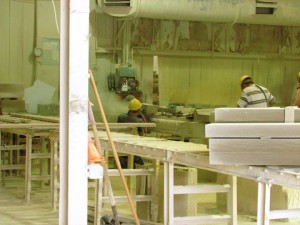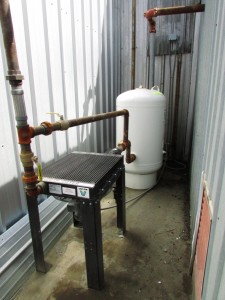Compressed Air Dryer Application
Our Midwest regional sales manager, Dave Ottinger, recently worked with manufacturer of architectural lime stone products and solved some longstanding moisture and pressure problems in the compressed air system. Deliquescent dryers are great in operating environments like this -- dusty, dirty, and harsh. Industries with similarly harsh environments include saw mills, Ready Mix plants, cement manufacturing, underground mines, and more.
Here is the application spotlight that Dave wrote-up for the next issue of the quarterly Vanguard Newsletter.
Indiana Limestone Company (ILC) formed in 1926. The company quarries and crafts the highest quality limestone found anywhere in the world. ILC has supplied materials to the Biltmore Estate, the Empire State Building, the Pentagon, and many other notable architectural icons.
Willie Walden is ILC’s Plant Maintenance Superintendent. According to Mr. Walden, ILC has had frequent problems with moisture in the compressed air system.
ILC employs seven craftsmen who use air grinding and cutting tools that chip away at the limestone to form the specialized shapes. In the past, these craftsmen were often slowed down by air tools damaged with moisture in compressed air lines.
ILC operates two 500 SCFM Quincy rotary screw air compressors. Until recently ILC also operated a single 600 SCFM Hankison heatless regenerative compressed air dryer. The dryer was located in the hot compressor room. High ambient temperatures are not good for air dryers. The Hankison unit experienced frequent mechanical failures. The extremely dusty environment and intense heat helped destroy the dryer. To make matters worse, the dryer was undersized relative to the plant’s required compressed air capacity. The dryer had become a choke point in the air system, starving workers’ tools of minimum pressure requirements during periods of high air demand. All seven craftsmen could not simultaneously operate air tools. According to Mr. Walden and Plant Manager Duffe Elkins, over the last several years these issues cost ILC countless thousands of dollars in lost productivity.
The dryer needed to be replaced.
ILC considered rebuilding the Hankison unit or replacing it with a new regenerative desiccant dryer.
Ultimately ILC determined that its operations do not require the -40F pressure dew point that a regenerative dryer delivers. Yet given the dusty operating environment a refrigerated dryer would not be an ideal solution either. ILC turned to Van Air Systems and a model D30 deliquescent dryer.
The deliquescent (deli-kwe-sent) dryer is a specialty compressed air dryer, ideal for use in applications where regenerative and refrigerated dryers are not ideal solutions. Dusty and dirty operating environments are often ideal locations for a deliquescent dryer, which has no moving parts or power requirement. A deliquescent dryer used with Dry-O-Lite desiccant suppresses compressed air dew point 20F below the inlet saturated temperature.
The fluctuating dew point provided by the D30 dryer would provide the much needed protection for the expensive pneumatic grinders year round. The low pressure drop of the D30 dryer would also allow each worker more than sufficient air to work simultaneously and indefinitely.
Several months after installing the D30 dryer, along with an AC series trim cooler, MDV-400 series automatic drain, and F200 series particulate after-filter, Mr. Walden reports great improvement in ILC’s air system. With less than one 1 PSI of pressure drop across the dryer, ILC craftsmen’s pneumatic tools are no longer starved for air. More importantly, the plant air system has seen no moisture since installing the D30.
The photo below shows the new D30 dryer installed outdoors, adjacent to the ILC compressor room.
Plant Manager Duffe Elkins reports being very satisfied with his investment in a new Van Air Systems dryer. He only wishes he’d would have done this years ago.


